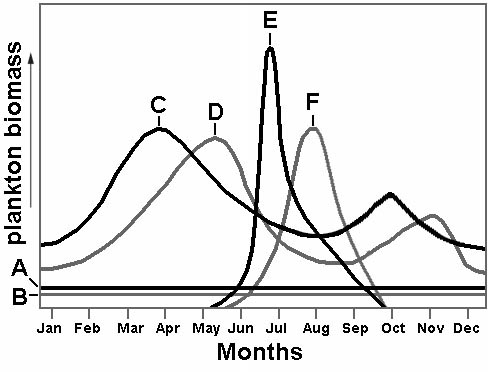1. The oceanographic term that means floating or drifting - relating to both microscopic and macroscopic organisms is:
a. plankton or planktonic.
b. nekton or nektonic.
c. benthos or benthic.
d. poikilothermic or homeothermic.
2. The oceanographic term that means swimmers - relating to organisms including fish, squids, and marine mammals is:
a. plankton or planktonic.
b. nekton or nektonic.
c. benthos or benthic.
d. littoral or limnetic.
3. The oceanographic term that means open-water environment - applies to organisms that live in open-water settings is:
a. pelagic.
b. planktonic.
c. estuarine.
d. limnetic.
4. The oceanographic term that means lives on the seabed - includes sessile or mobile organisms.
a. plankton or planktonic.
b. nekton or nektonic.
c. benthos or benthic.
d. littoral or limnetic.
5. The ability of an organisms to blend in (hide or disguise) in an environment using special coloration, patterns, or body shapes:
a. caumoflage.
b. pelagic.
c. homeothermic.
d. top shading.
6. A common method of hiding from predators and prey where the top of the organism is dark colored and the bottom is light colored:
a. caumoflage.
d. poikilothermic.
c. top shading.
d. homeothermic.
7. Animals that are cold blooded, matching the temperature of the environment are called:
a. neritic.
b. nektonic.
c. homeothermic.
d. poikilothermic.
8. Animals that are warm blooded, using food energy to raise the temperature of their bodies above the temperature of the environment are called:
a. homeothermic.
b. pelagic.
c. neritic.
d. poikilothermic.
9. Salinity is one of the factors the factors that many species have a tolerance range within which they can survive. Seawater has about 35 grams of salt per liter of water. pH is another factor. Many species can only tolerate normal seawater. What is the pH of normal seawater?
a. 6.5
b. 7.0
c. 8.1
d. 10.0
10.Seawater is a buffered system (meaning it's pH is naturally controlled in a range). If it gets too acidic then:
a. CaCO3 dissolves.
b. CaCO3 precipitates.
c. water pressure increases.
d. water temperature decreases.
11. Many species have symbiotic relationships with other organisms. When two or more species benefit each other it is called:
a. mutualism.
b. parasitism.
c. commensalism.
d. predation.
12. The bottom parts of the ocean that totally dark even during daylight hours is called the:
a. littoral zone.
b. aphotic zone.
c. epipelagic zone.
d. benthic zone.
13. The stable number of individuals in a community within a confined geographic region is called:
a. carrying capacity.
b. predator and prey relationship.
c. zoning.
d. the extinction boundary.
Questions 14 to 19 relate to the illustration below that illustrates primary production in the Pacific
Ocean along the West Coast of North America. The six lines (3 pairs) show changes in plankton
biomass in tropical, temperate, and polar regions during months of a yearly cycle.

14. Which lines represent phytoplankton production?
a. lines A and B
b. lines C and D
c. lines B, D, and F
d. lines A, C, and E
15. Which lines represent zooplankton production?
a. lines A and B
b. lines C and D
c. lines B, D, and F
d. lines A, C, and E
16. Which lines represent polar regional production?
a. lines A and B
b. lines E and F
c. lines B, D, and F
d. lines A, C, and E
17. What would explain the two peaks in biomass production represented by line C?
a. An increase in sunshine occurs during summer months.
b. Periods of coastal upwelling in the spring and fall cause blooms in phytoplankton production.
c. Periods of coastal upwelling in the summer and winter cause increases in zooplankton production.
d. Warm weather in the fall and spring seasons occur along coastal California.
18. What would explain the shape of lines A and B?
a. There is more zooplankton production in the oceans than phytoplankton.
b. Tropical regions have a thermocline year round that prevent upwelling of nutrient rich waters.
c. Polar regions are too cold to support primary production.
d. There is no primary production in the region of the ocean represented by lines A and B.
19. What would explain the pattern of biomass production for lines E and F?
a. Biomass production is greatest in tropical regions during the summer months.
b. In polar regions, there is a bloom of zooplankton proceeding an increase in phytoplankton.
c. In polar regions, there is a bloom of phytoplankton proceeding an increase in zooplankton.
d. Zooplankton and phytoplankton migrate north from California to Alaska in the summer months.
20. An area where special environmental circumstances have allowed a viable population of a species to survive after extinction occurred in the surrounding area is called:
a. acatastrophe.
b. a exotic species habitat.
c. an invasive species habitat.
d. a refugia.
|
